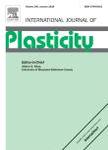版权所有:内蒙古大学图书馆 技术提供:维普资讯• 智图
内蒙古自治区呼和浩特市赛罕区大学西街235号 邮编: 010021

作者机构:Tech Univ Darmstadt Inst Mat Sci D-64287 Darmstadt Germany Lawrence Livermore Natl Lab Phys & Life Sci Directorate Livermore CA USA Univ Politecn Madrid Inst Fus Nucl E-28006 Madrid Spain Univ London Imperial Coll Sci Technol & Med Dept Phys London SW7 2AZ England Culham Sci Ctr CCFE Abingdon OX14 3DB Oxon England
出 版 物:《INTERNATIONAL JOURNAL OF PLASTICITY》 (国际塑性力学杂志)
年 卷 期:2015年第65卷
页 面:108-130页
核心收录:
学科分类:08[工学] 0805[工学-材料科学与工程(可授工学、理学学位)] 0802[工学-机械工程] 0801[工学-力学(可授工学、理学学位)] 080102[工学-固体力学]
基 金:U.S. Department of Energy by Lawrence Livermore National Laboratory [DE-AC52-07NA27344] DOE's Early Career Research Program Consejo Social PhD program of the Universidad Politecnica de Madrid Centre for Doctoral Training on Theory and Simulation of Materials at Imperial College London - EPSRC [EP/G036888/1] European Union's Horizon research and innovation programme United Kingdom Engineering and Physical Sciences Research Council [EP/G050031] RCUK Energy Programme [EP/I501045] EPSRC [EP/I501045/1] Funding Source: UKRI
主 题:Dislocations Metallic material Numerical algorithms Ductility
摘 要:Thermally-activated 1/2 screw dislocation motion is the controlling plastic mechanism at low temperatures in body-centered cubic (bcc) crystals. Dislocation motion proceeds by nucleation and propagation of atomic-sized kink pairs in close-packed planes. The atomistic character of kink pairs can be studied using techniques such as molecular dynamics (MD). However, MD s natural inability to properly sample thermally-activated processes as well as to capture {110} screw dislocation glide calls for the development of other methods capable of overcoming these limitations. Here we develop a kinetic Monte Carlo (kMC) approach to study single screw dislocation dynamics from room temperature to 0.5T(m), and at stresses 0 sigma 0.9 sigma(P), where T-m and sigma(P) are the melting point and the Peierls stress. The method is entirely parameterized with atomistic simulations using an embedded atom potential for tungsten. To increase the physical fidelity of our simulations, we calculate the deviations from Schmid s law prescribed by the interatomic potential used and we study single dislocation kinetics using both projections. We calculate dislocation velocities as a function of stress, temperature, and dislocation line length. We find that considering non-Schmid effects has a strong influence on both the magnitude of the velocities and the trajectories followed by the dislocation. We finish by condensing all the calculated data into effective stress and temperature dependent mobilities to be used in more homogenized numerical methods. (C) 2014 Elsevier Ltd. All rights reserved.